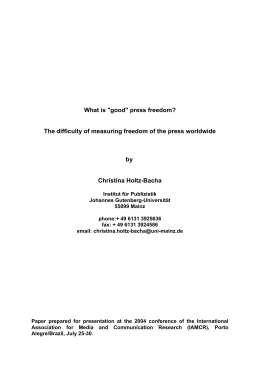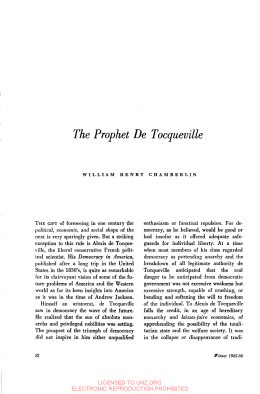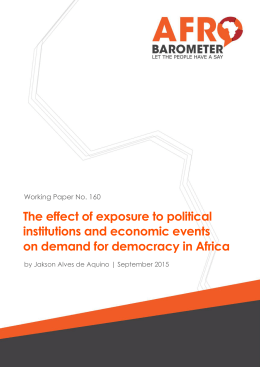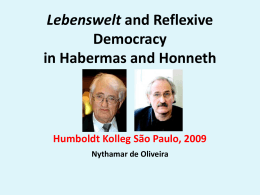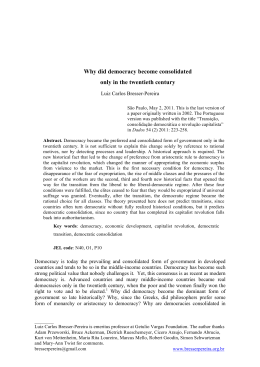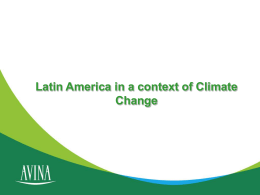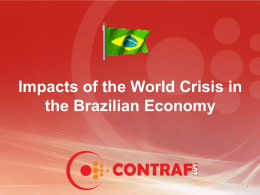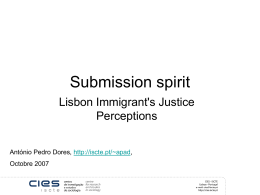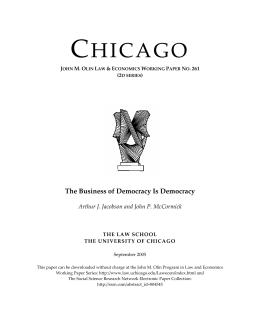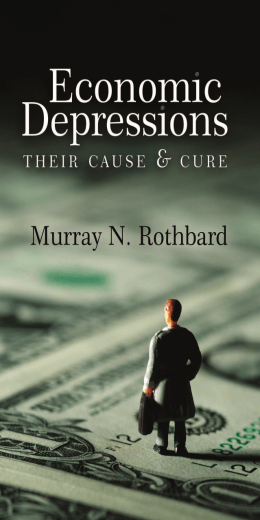Do democratic institutions forge a demand for democracy? An investigation of Latin American citizens attitudes Jakson Alves de Aquino Federal University of Ceará (Brazil) Michigan State University (USA) [email protected] Presented at the 73 Annual Midwest Political Science Association Conference Chicago, April 16–19, 2015 rd Abstract Recent research on Latin America have found that younger people are willing to live under democracy less than older people. The economic performance of political regimes is sometimes considered important to define these attitudes. In this research, I used data from AmericasBarometer and other country level data to calculate variables that measure respondent’s exposure to both democracy and economic events. Using multilevel models, I found that higher demand for democracy by older people is dependent on their exposure to democracy during their adult life, and I did not find long term effects of economic events. I interpret the findings as meaning that people living under democracy are subject to socialization processes that make them demand democracy. The methodology used in this research has the the potential of helping to disentangle how much of the influence of national events and institutions operates at the national and at the individual levels. 1 Introduction Elites, because not numerous, can much more easily overcome collective action problems than the mass of lower class people. Usually, changes in the political regime are pushed by the elites, but they can not succeed if the mass offers strong opposition. Hence, the strength of common citizens desire to live under a democratic regime is important for both democratization and democracy breakdown. One of the basic drives of life is the willingness to survive, and, at least in capitalist societies, people keep striving to improve their standard of life far beyond the minimum requirements for survival. In a contemporary capitalist society, the economic growth and the distribution of wealth are two of the national variables most correlated with survival and standard of life, and not surprisingly, national economic performance is usually seen as a key factor to make people decide whether to support a political regime. Once survival is no longer a problem, the importance of freedom increases, and people living under democratic regimes may learn to appreciate the peaceful resolution of conflicts and the higher degree of freedom that characterize democracies when compared with authoritarian regimes. In this article, I investigate the long term effects of economic performance and political regimes on individuals manifest demand for democracy in twelve Latin America countries. I use AmericasBarometer survey data to measure the demand for democracy, and combine these data with country level variables to measure how much individuals have experienced democracy and how the economy has performed during their adult lives. 2 Demand for democracy Mattes and Bratton (2007, footnote 3) argue that generalized notions of system support sometimes blends regime preferences and regime evaluations, and, in this article, I opted for using the expression Demand for democracy to refer to how much people are willing to live under a democratic regime. According to Chu et al. (2008, p. 77), the survey question most widely used to measure demand for democracy is: 1 Which of the following statements do you agree with the most: 1. For people like me it doesn’t matter whether a government is democratic or non-democratic, or 2. Democracy is preferable to any other form of government, or 3. Under some circumstances an authoritarian government may be preferable to a democratic one. The demand for democracy is higher when measured by abstract questions such as the above one. More specific contexts give rise to weaker manifest preference for democracy (Chang, Chu and Park, 2007; Mattes and Bratton, 2007, p. 72). Canache (2012) examined respondents’ answers to an open question about the meaning of democracy from the 2006–2007 AmericasBarometer and found that the word democracy may be associated to political concepts, such as freedom, rule of law, political equality and participation, but also to societal outcomes like economic prosperity and social equality, and negative meanings. According to Inglehart (2003), economic development creates favorable conditions for democratization but democratization is not necessarily favorable to economic development. People worried with survival are more prone to support any political regime that seems promising in raising their standard of living than people who do not see any important threat to the satisfaction of their basic material needs. The later have higher propensity to value freedom of expression, tolerate cultural diversity and trust other people. Therefore, they form a better base of support for democracy. In summary, economic development nurtures self expression values and these, then, form a better environment for democracy to thrive (Inglehart, 2003, p. 56). This theory has found support in other investigations. For example, using data from the World Values Survey from 1997, Ribeiro (2008) has found a positive association between demand for democracy and post-materialist values among Brazilians. Also, according to Andersen (2012, p. 28), people of higher income support democracy more than people of lower income, especially in countries with low economic inequality. However, Chu et al. (2008) have found empirical evidence that challenges the modernization theory: 2 Contrary to the received view | that a rising level of economic development promotes “self-expression values” such as freedom of speech and participation in the decision-making process, we found that people’s economic evaluations had the strongest impact on support for democracy in the high-income countries, and the weakest impact in the low-income countries (Chu et al., 2008, p. 81–82). If people support democracy because they believe that it will foster economic development and decrease economic inequality, the support will be withdrawn if such expectations are not fulfilled in a few years after democratization. In this case, it is expected an increase in the approval of populist leaders that defend that the institutions of liberal democracy—such as partisan competition and subordination of president to Congress—are more an obstacle than a way of realizing the peoples’ desires (Bratton and Mattes, 2001, p. 448; Seligson, 2007, p. 82). On the contrary, if people support democracy because they believe in its intrinsic value, the chances that the regime will survive to economic crises are higher (Mattes and Bratton, 2007). Chang, Chu and Park (2007, p. 75) and Chu et al. (2008, p. 85) argue that it is harder for a citizen of a democratic country to be happy with its democracy if the country was governed in the recent past by an economically successful authoritarian regime, and according to Chang, Chu and Park (2007, p. 77), people in East Asia developing countries became disillusioned with democracy because economic and social conditions did not improve as expected after democratization. Some authors argue that Latin America citizens are particularly worried about the economic performance of their democracies (Lagos, 2008; Fernandez and Kuenzi, 2010), and Benton (2005) has confirmed that Latin American voters punish incumbents by voting in nonincumbents when they are blamed for economic adversities while Chu et al. (2008, p. 84) observe that in different regions of the world economic and political factors have different weights in the explanation of people’s evaluation of democratic regimes: Trust in democratic institutions and the free and fair voting process does the most to encourage popular approval of the way that democracy works. People’s evaluation of national economic conditions also matters, and its impact lags only slightly behind 3 that of the various political indicators […]. This global pattern holds up well among Africans, Asians, and Arabs. In Latin America, by contrast, perceived national economic conditions matter more than political factors, but not by much. (Chu et al., 2008, p. 84) The economies of Latin America colonies were organized to produce and transfer raw materials to their metropolitan states. The enslavement of both native and African people was ubiquitous. The cultural inheritance of the colonial era is a highly hierarchical society and also a distinction between poor and rich people so strong that poor non white people are seen as somewhat less than humans and are treated with notably less dignity than the rich decedents of white Europeans. This context exerts a strong pressure over democracy. As Lagos argues, Latin America is a region with […] extremely limited social mobility: 86 percent of those born in the last generation to parents with only primary education themselves attain only primary education. […] An individual’s future is determined by birth, and people expect democracy to change this (Lagos, 2008, p. 124). In a country with an authoritarian regime, high social inequality may have strong effects on the prospects of democratization. While most people may see a change in the regime as an opportunity to decrease social inequality, the elites may be afraid of being more heavily taxed with the democratization of the society. If the society is democratic, high inequality increases the risk of breakdown because the elites would not find strong resistance from the mass of people (Houle, 2009; Freeman and Quinn, 2012; Córdova and Seligson, 2010). The perspective of democratization is higher for authoritarian countries with turbulent political past, with a history of relatively frequent regime transitions. According to Houle (2009, p. 615), however, the number of regime transitions is not a key predictor of democratic consolidation. Zarate Tenorio (2014) investigated the relationship between collective protest and social spending in Latin America and found that the organized labor was successful in making governments spend more in social security and welfare while protest by other groups does not affect spending in 4 education and health. Hence, a democratic environment is favorable for decreasing social inequality not only because voters may choose leaders who promise egalitarian policies, but also because the disadvantaged have more freedom to protest and, consequently, to influence the decision making process. Berger and Luckmann (1966) presented a sophisticated theory on how people develop patterns of behavior during daily interactions with other people, and how they become unconscious of the origins of their social habits. In Berger and Luckmann’s theory, the patterns of behavior acquired during the first years of life—from the interactions with parents and other persons highly important for infants—have an enduring imprinting in individuals personality. They refer to this first stage of becoming a member of the society as primary socialization. Although children and adolescents are not emancipated citizens yet, periodic elections make their parents’ political preferences more salient and may contribute to a vision of electoral democracy as something normal (Sears and Valentino, 1997). The national political regime might be used as a model on how to make decisions and, thus, contribute to the institution of democratic procedures within other institutions, such as schools (Torney-Purta, 2002). An environment of freedom of speech may also favor open classroom discussions, which help in the development of sophisticated reasoning on social issues by the use of logic to check the internal coherence of arguments and of empirical evidences to support arguments. Moreover, open discussions help people to understand and tolerate other’s positions (Rossi, 2006, p. 113). In summary, if the institutions of Latin American political regimes successfully indoctrinate children and teenagers with the values most favorable to the maintenance of political systems at theses early phases of life, we will find a correlation between demand for democracy and how authoritarian or democratic the regime was when individuals were young. However important the primary socialization may be to the formation of the personality of an individual, politics usually is not a subject very frequently discussed in most homes. Politics matters more when individuals are mature enough to understand abstract concepts such as government, political party, and democracy, and when their interactions with strangers become more frequent. 5 Thus, over the basic values developed at their parents’ home, individuals political ideas may evolve mainly after primary socialization is no longer the main process shaping the individual values and attitudes. This process of continuous adaptation to the larger society, which goes on for the individuals’ entire life, Berger and Luckmann called secondary socialization. If the influence of political regimes are exerted mainly through processes of secondary socialization, we will find significant correlation between the contact the individual has had during their adult lives with democratic and autocratic regimes. Regime transitions may be periods particularly disruptive to the daily lives of common citizens, and may also have their own influence on attitudes formation. I devise two possibilities: (1) individuals who witnessed many regime transitions become used to them and see the overthrow of elected officials as a normal way of solving national problems, or, on the contrary, (2) they think that it is not worthwhile the violence sometimes required to depose a chief of State and free and fair elections would be a proper way of choosing a new leader. As we have seen, some authors argue that the evaluation of how competent the government was in dealing with the national economy is an important criterion used by people to choose among candidates in national elections. But what is the long term impact of the national economy over individuals attitudes toward democracy? Do people perform some kind of either conscious or unconscious computation of how good for the economy the political regimes were during the democratic and authoritarian periods under which they have lived? If the answer to this question is yes, we should find a positive correlation between demand for democracy and an experience of democracy and high economic growth, low rates of inflation and reduction of social inequality and/or autocracy and low economic growth, high rates of inflation and increase in inequality (and the inverse: a negative correlation with an experience of democracy and low economic growth, high inflation and increase in inequality and/or autocracy and high growth, low inflation and decrease of inequality). The process of socialization (primary and secondary) is far from being an atomistic process in which individuals develop opinions and attitudes based solely on their own experiences. They talk with each other, share their experiences and form their opinions together. According to Jost, Ledgerwood and Hardin (2008, p. 173), 6 “people are motivated to achieve mutual understanding or ‘shared reality’ with specific others in order to (i) establish, maintain, and regulate interpersonal relationships […] and (ii) perceive themselves and their environments as stable, predictable, and potentially controllable”. If this phenomenon happens in a national scale and is strong enough to overcome more individualistic and dyadic processes of socialization, we could find correlation between two variables only at the national level. Alternatively, this process of cultural transmission may find strong boundaries within countries (Flockhart, 2006), and in this case we would find the development of national class cultures. The poor people could have values and attitudes diverse from the most affluent; the organized working class and non organized laborers could have different ideologies. In addition to country level variables, used as indicators of historic, social and political contexts, many individual level variables have been pointed by the literature as having explanatory power on attitudes toward democracy and will be used in this investigation as control variables: perception of corruption, trust in institutions, interpersonal trust, evaluation of government performance, respondent’s ideological position feelings of insecurity due to high criminality rate, and others (Bratton and Mattes, 2001; Bohn, 2012; Doyle, 2011; Chang, Chu and Park, 2007; Fernandez and Kuenzi, 2010; Gunther and Monteiro, 2003; Mattes and Bratton, 2007; Seligson, 2007). Specially interesting for this research is age, since recent studies on public opinion on democracy in Latin America have found that the youth is less supportive of democracy than older adults, a fact that undermines the prospects of democracy consolidation (Lagos, 2008, p. 112; Seligson, 2007, p 92). Seligson, for instance, says: Across the region as a whole […] the results regarding age and populism should be seen as sobering. For they suggest that as the young people of today become tomorrow’s electoral majorities, populism’s appeal against the many checks, balances, rules, and frustrations of liberal democracy will only grow (Seligson, 2007, p. 92). 7 3 Data The 2012 AmericasBarometer dataset has 494 variables and 28021 cases, corresponding to interviews conducted in 18 countries (LAPOP, 2012).1 However, I had to eliminate the data from five countries due to either missing or invariability of data at the country level: Belize is missing from Polity IV, Costa Rica and Jamaica have no variation in Polity IV scores, and Guyana, Haiti and Nicaragua are missing from Penn Table. I also deleted 136 cases with missing age and 302 cases with more than 2 missing values among the 4 variables that I used to build the index of demand for democracy, remaining 18027 cases in the dataset. In 2012, AmericasBarometer asked 13 questions on attitudes toward democracy. A principal component analysis including all 13 questions reveals that the questions’s replies represent four distinct dimensions of attitude toward democracy, but in this paper I will only explore the first dimension, which corresponds to a demand for democracy and is the dependent variable explained in this paper.2 The variables reflecting the political and economic contexts were calculated from the historical series of Polity IV in 2012 (Marshall, Jaggers and Gurr, 2014), Gini index in 2011 (Solt, 2014), Gross Domestic Product in 2011 (Feenstra, Inklaar and Timmer, 2013) and Inflation (THE WORLD BANK, 2015). Figure 1 shows the variation of Polity IV (black line), Gini Index (red) from 1960 to 2011. The Gini data include information on how reliable the data is and the band following the red line indicates the 95% confidence interval of the Gini value (Feenstra, Inklaar and Timmer, 2013). The correlation between the two variables is below each graphic. It is notable how the Gini data become reliable only in recent years. Figure 2 shows Polity IV (black line), Inflation (red) and Gross Domestic Product Growth (blue). The left Y axis shows the minimum and maximum values of the Inflation, and the right axis shows the limits of Economic growth. The correlations between Polity IV and the two other variables is shown below each graphic. 1 We thank the Latin American Public Opinion Project (LAPOP) and its major supporters (the United States Agency for International Development, the United Nations Development Program, the Inter-American Development Bank, and Vanderbilt University) for making the data available. 2 See Table 6, at Appendix A for a list of indexes created through principal component analysis. 8 −10 Polity IV −10 10 Polity IV −10 Polity IV 10 0.65 −10 0.30 r = 0.71 2011 Polity IV 10 0.65 El Salvador r = −0.21 2011 Polity IV 10 0.65 Uruguay Polity Gini r = 0.26 1960 Figure 1: Polity IV and Gini Index — 1960–2011 9 −10 −10 0.30 Gini Polity IV −10 0.30 Gini Polity IV −10 10 0.65 Gini 0.30 Paraguay 1960 Honduras 2011 2011 Gini Polity IV −10 10 0.65 0.30 Gini 2011 r = 0.18 r = −0.40 1960 Guatemala r = −0.88 10 0.65 0.65 0.30 −10 10 0.65 0.30 Gini 2011 1960 Peru 1960 Ecuador r = 0.44 2011 Gini Polity IV 10 0.65 0.30 Gini 2011 1960 r = 0.47 1960 Dominican Republic r = −0.12 Panama 0.30 −10 2011 1960 2011 Gini Polity IV 10 0.65 0.30 Gini r = −0.25 r = −0.59 1960 Colombia 1960 Polity IV 2011 1960 10 0.65 0.30 r = −0.21 1960 Mexico Gini −10 0.30 Gini Polity IV 10 0.65 Brazil 2011 1.09 r = 0.41 Honduras r = 0.04 Polity Inflation 10 Growth Growth r = −0.02 r = 0.10 r = −0.30 Growth r = 0.05 Paraguay r = −0.18 El Salvador r = 0.03 Uruguay r = 0.15 Growth Figure 2: Polity IV, Inflation and Economic growth — 1960–2011 −0.15 Growth 7481.66 0.11 Peru 0.10 0.19 r = 0.17 −0.07 −0.15 r = 0.15 −0.08 37.26 Growth 16.27 0.05 0.15 Panama 0.07 −0.86 r = −0.38 3.20 0.59 −0.10 0.10 Growth 131.83 Inflation Growth 2947.73 Inflation −0.07 r = −0.35 −0.11 31.94 Growth Inflation −0.08 33.71 r = −0.16 0.09 −2.68 Inflation Growth 0.13 2.28 Inflation 0.07 Mexico −0.11 r = 0.08 125.34 r = −0.06 −0.16 51.46 Dominican Republic Inflation Growth Ecuador 0.20 −3.90 r = 0.47 4.36 r = 0.09 r = −0.38 −0.10 96.09 Inflation Colombia Inflation Growth Guatemala 0.05 2.28 r = 0.47 −0.05 41.22 r = 0.25 0.07 −0.80 Inflation r = 0.73 r = −0.38 Inflation Growth 33.97 Inflation r = 0.14 −0.08 Inflation Brazil I used country level data to calculate both country and individual level variables that measure how much countries as whole and each respondent in particular were exposed to political and economic upheavals. The country level variables correspond to the last 50 years of the data, that is, the period 1963–2012. I consider that this period is long enough for the crystallization of opinions and attitudes that evolve at the national level. The individual level variables correspond to the adult life of respondents, that is, from the year that they turned 18 years old to 2012. The only exception is the mean score of Polity IV when the respondent was an adolescent (age between 13 and 17). I used the Polity IV variable that attributed scores ranging from −10 to +10 to almost all years, including periods of transition (Marshall, Jaggers and Gurr, 2014, p. 15). Countries with scores from +6 to +10 are considered democratic.3 I subtracted 5 from the Polity IV scores to make authoritarian regimes to have negative scores and democratic regimes to have positive scores. This procedure has made the range of scores about three times longer for authoritarian regimes (from −15 to 0) than for democratic ones (from 1 to 5). To make the two ranges equal, I divided the values < 0 by 3 before calculating the variables that involve multiplication. Based on Polity IV, I created four variables at both country level and individual level: • Number of years of democracy. • Number of years of authoritarian regime. • Mean value of Polity IV. • Number of transitions, that is, when Polity IV score increased to above 5 or decreased to below 6. The variable that was used to evaluate the effect of social inequality on Demand for democracy was the yearly Gini index difference which is the difference between the Gini index of a year and the previous year. That is, a positive value means an increase in the country’s inequality when compared to the previous year. In some Latin America countries, the Gini index data goes back as far as 1964, while for others the first year with data is decades later. Paraguay was the last country to start having Gini index data, on 1991. The Gini dataset has 55% of missing values in the period 3 See: http://www.systemicpeace.org/polityproject.html. 11 1964–1990, but only 2% of missing values during 1991–2012. The annual economic growth was calculated from Penn World Table 8.0 data. The Penn World Table 8.0 has data from 1950 to 2011, what makes it possible to calculate the growth rate for the period 1951-2011. For the respondents who turned 18 after 2011, I used the 2011 Polity IV value as the mean value of Polity IV · Economic growth; for those who turned 18 before 1951, I used only data from the period 1951–2011. Following Feenstra, Inklaar and Timmer (2013, p. 30) recommendation, I used the variable RGDPNA (Real Gross Domestic Product based on National Accounts) to calculate the growth rate. For each year, I centered the country growth rates around the mean growth rate value of all countries in the table (and not only the countries in this study). Both deflation and high inflation are considered detrimental for the economy, and according to Billi and Kahn (2008) the optimal rate of inflation is around 1%. Hence, I use the absolute value of the rate of inflation centered at 1%. The greatest deflation was −4 (transformed to 5 in our variable), and was registered at Dominican Republic on 1961; the highest inflation rate was 7482 (transformed to 7481), registered at Peru on 1990. From the 604 data points available, in only 31 country–years, the inflation rate was between 0 and 1, and hence, became negative when transformed. For each of the tree economic datasets (Gini index, Economic growth and Inflation), I created both the country and the individual level variables in two different ways: • The difference between the mean value of the economic variable in democratic years and its mean value in non-democratic years. I attributed the value 0 to these variables when the respondents’ adult life was entirely lived under democracy. The variables calculated in this way do not use the full range of Polity IV scores and, thus, are less fine grained. • The mean value of the multiplication of the economic variable and Polity IV for each year (explained below). The calculus of the variables that involve the multiplication of Polity IV and economic variables was done in two steps: (1) multiplication of Polity IV and the economic indicator for each year of respondents’ adult life; (2) calculation of the mean value of the multiplications. Because the value of Polity IV might be positive or negative, and the value of the economic variables also might be 12 positive or negative, for each year and for each respondent, we have the possible results shown in Figure 3. Polity IV Democracy Democracy Autocracy Autocracy Economic variable + − + − Result + − − + Figure 3: Possible results of multiplication variables For each year, the variable will have a positive value if either the country was democratic and the economic variable was positive or the country was autocratic and the economic variable was negative. The value will be negative in the inverse circumstances. For example, because economic growth is regarded as a positive event by most people, the values of Polity IV · Economic growth will be positive in the circumstances that we hypothesize to forge favorable attitudes towards democracy (or negative attitudes toward autocracy) and will be negative in the inverse circumstances. In other words, we expect a positive correlation between the variables Demand for democracy and Polity IV · Economic growth. Because both inflation and inequality are negative things, it is expected a negative correlation of Demand for democracy and both Mean Polity IV · Inflation and Mean Polity IV · yearly Gini index difference. In summary, we have a set of 21 variables to evaluate the long term effects of political and economic events on individual’s attitudes toward democracy: 10 variables at the country level and the equivalent to the same 10 variables plus Polity IV during adolescence at the individual level. Many other variables will be used as control. At the country level, the Gross Domestic Product in 2011, The Gini index in 2011, the Polity IV score in 2012, and the Proportion of violent crime. This last one is derived from the AmericasBarometer. At the individual level, we will use variables from the AmericasBarometer, as detailed in the Appendix A. I opted for creating indexes measuring many of the opinions and attitudes explored by the AmericasBarometer survey, and including as control variables in the final HLM models all indexes that proved to be statistically significant. With this procedure, I expect to decrease to a minimum the risk of variable selection bias: if the variables 13 created to measure the socialization processes have significant effect on Demand for democracy it will not be because a relevant control variable that is present in the data is missing from the analysis. 4 Results Figure 4 shows the distribution of the Index of demand for democracy by country. Most countries have about the same level of demand for democracy, but the demand is visibly lower in Honduras −1 −3 −2 Index 0 1 and higher in Uruguay than in the other countries. HND GTM ● ● ● ● ● ● ● ● ● ● ● ● ● ● ● ● ● ● ● ● ● ● ● ● ● ● ● ● ● ● ● PER SLV ECU BRA DOM COL PRY ● ● ● ● ● ● ● ● ● ● ● ● ● ● ● ● ● ● ● ● ● ● ● ● ● ● ● ● MEX PAN URY Country Figure 4: Index of demand for democracy by country According to Luke (2004, p. 32), it is not appropriate to show significant tests in multilevel regression models. Thus, in the regressions presented in this paper, I consider statistically significant the coefficients whose associated t statistics have high absolute values.4 Table 1 presents the multilevel null model for our dependent variable. The intraclass correlation coefficient is 0.08, that is, less than 10% of the variation is potentially explained by variables at the country level. Although this value is low, I opted for conducting multilevel regressions to check what country level variables have significant impact over the demand for democracy when controlled by the individual levels variables. 4 The multilevel regression analyses were performed by the function lmer from lme4 package (Bates et al., 2014). 14 Table 1: Demand for democracy: null model Estimate Std. Error (Intercept) 0.00 BIC 49877.42 Num. obs. 18027 Num. groups: country 12 Variance: country.(Intercept) 0.076 Variance: Residual 0.927 4.1 t value 0.08 0.05 Control variables Before including the independent variables in the HLM models, we will see the impact of the control variables on Demand for democracy. Only variables whose correlation with Demand for democracy has a t statistics > |3| will be included in the final HLM models. First, we will check what country level variables have correlations with demand for democracy significant enough to be included in further analyses (Table 2). Table 2: Demand for democracy explained by country level variables Model 1 Model 2 Model 3 Model 4 (Intercept) GDP in 2011 −0.02 (−0.16) 0.10 (0.37) −0.84 (−1.69) 2.31 (2.24) 0.46 (2.37) 0.11 (1.72) Polity in 2012 −0.05 (−2.24) Gini Index in 2011 −4.22 (−2.50) Violent crime BIC 49887.99 Num. obs. 18027 Num. groups: Country 12 Variance: Country.(Intercept) 0.08 Variance: Residual 0.93 49888.14 18027 12 0.06 0.93 49888.53 18027 12 0.06 0.93 49879.04 18027 12 0.05 0.93 Gross Domestic Product in 2011 has near zero impact over the Demand for democracy (t = 15 0.37). The current level of democracy, measured by the Polity IV score in 2012, has a positive effect on the Demand for democracy, although not statistically significant (t = 1.72). As expected, the correlation is positive: respondents of more democratic countries have a higher demand for democracy. The Gini index in 2011 has a negative effect on Demand for democracy. Citizens of countries with higher inequality have a lower demand for democracy, but the significance of the correlation is still below our threshold (−2.24). The country rate of Violent crime also has a clear impact on Demand for democracy, but below the threshold for a control variable (t = −2.50). The variables that measure opinions and attitudes have the most significant impact on the variation of Demand for democracy. But the individuals’ biographical trajectory and current socioeconomic conditions have an impact on their opinions and attitudes. Hence, before presenting a model including only the most significant explanatory variables, I will present three models: (1) biographical and sociodemographic variables, (2) opinion and attitude variables, and (3) all control variables. The first model in Table 3 includes biographical and socioeconomic variables used in this paper as control variables. As others who have researched attitudes toward democracy in Latin America, we found that older people demand democracy more than young people. Number of years of schooling, Household monthly income and Increase in household income have strong positive effect on the Demand for democracy, as expected by modernization theory. The negative effect of Dwelling location is unexpected. Actually, if Dwelling location were the only explanatory variable in a HLM model, its effect on Demand for democracy would not be significant (t = −0.54). Its t value becomes significant when we add to the model either Years of education (−3.33) or Household monthly income (−4.24). In the Opinion model, the variable with the strongest positive impact is Support for peaceful protests and the one with the strongest negative impact is Support for violent protests. Actually, Demand for democracy, Support for peaceful protests and Support for violent protests are positively correlated with each other; it is only when controlled by Support for peaceful protests that the correlation between Demand for democracy and the Support for violent protest becomes negative. 16 Table 3: Demand for democracy explained by control variables Biographical Opinion All 17 (Intercept) −0.57 (−7.68) Age 0.01 (12.59) Years of education 0.02 (10.82) Household monthly income 0.02 (8.15) Household income (Increased) 0.10 (4.91) Dwelling location (Urban) −0.10 (−5.75) Support for peaceful protests Support for violent protests Statism Political information Political tolerance Alienation Feeling of security Political participation Support for government Trust in political institutions Approval of homosexuals in office Left-Right position Satisfaction with economy People are (Trustworthy) Experience of corruption Civic participation BIC Num. obs. Num. groups: Country Variance: Country.(Intercept) Variance: Residual ⋆ Country level variable. 42476.30 15453 12 0.05 0.90 −0.02 (−0.59) 0.16 (20.30) −0.14 (−19.90) 0.10 (14.03) 0.08 (11.64) 0.08 (9.82) −0.05 (−6.26) 0.05 (7.33) −0.04 (−4.99) 0.03 (2.60) 0.07 (7.00) 0.05 (7.05) 0.03 (5.04) 0.02 (2.81) 0.04 (2.57) −0.01 (−1.95) −0.01 (−1.55) 46680.74 17665 12 0.02 0.81 −0.36 (−7.09) 0.01 (10.02) 0.01 (5.12) 0.01 (4.01) 0.04 (1.92) −0.06 (−3.61) 0.15 (17.74) −0.13 (−16.64) 0.11 (13.57) 0.07 (8.00) 0.08 (9.69) −0.03 (−3.93) 0.05 (6.25) −0.05 (−6.06) 0.04 (3.35) 0.07 (7.08) 0.05 (6.52) 0.04 (4.72) 0.02 (2.51) 0.02 (1.27) −0.01 (−1.95) −0.02 (−1.98) 40103.75 15182 12 0.02 0.80 Selected −0.34 (−6.74) 0.00 (9.56) 0.01 (5.31) 0.01 (5.19) −0.06 (−3.46) 0.15 (18.06) −0.13 (−17.12) 0.10 (13.51) 0.07 (8.06) 0.08 (9.96) −0.03 (−4.13) 0.05 (7.15) −0.05 (−6.94) 0.05 (4.49) 0.07 (7.18) 0.05 (6.56) 0.04 (5.12) 41489.49 15728 12 0.02 0.80 The other three highest correlations tell us that Latin American citizens who demand democracy also favor big governments, and, as expected, are politically well informed and tolerant. Most other variables also have the expected effect on Demand for democracy, one important exception being the negative effect of Political participation. Actually, if it were the only explanatory variable in a HLM model, its effect would be insignificant (t = 0.56). It only has a negative effect when controlled by Support for peaceful protest, Alienation, Trust in political institutions and Index of information. Interpersonal trust, Experience of corruption and Civic participation are less relevant for Demand for democracy in Latin America than claimed by part of the recent political science literature. Still in the Opinion model, it is important to note that Support for government and Trust in political institutions are positively correlated with Demand for democracy, although their t values are less significant than some other opinion and attitudes variables. Since almost all countries in this study currently have a Polity IV > 5, this confirms that, to some degree, people who manifest a Demand for democracy, in fact, are simply satisfied with the current democratic government and other political institutions. Indeed, as Table 4 shows, the correlation between Demand for democracy and both Support for government and Trust in political institutions is the lowest in the country with the lowest Polity IV score and it is the highest in the country with the highest Polity IV. The third model puts together all variables from the first two models. One variable that measures economic wellbeing—Increasing in household income—and Satisfaction with the national economy lost their statistical significance, while Household monthly income remained significant. Not surprisingly, people are more worried with their personal finances than with their country economies. Finally, the model Selected includes only the variables whose coefficients had a corresponding t > |3|. These variables will be used as controls in the final models (Table 5). 18 Table 4: Pearson correlations between Demand for democracy and two other variables in 12 countries Correlations Country Polity IV Supp. gov. Trust inst. Ecuador Honduras Colombia Mexico Paraguay Guatemala Dominican Republic El Salvador Brazil Panama Peru Uruguay 4.2 5 7 7 8 8 8 8 8 8 9 9 10 0.02 0.09 0.09 0.08 0.11 0.11 0.12 0.12 0.16 0.09 0.17 0.25 0.05 0.23 0.12 0.08 0.11 0.27 0.11 0.08 0.15 0.11 0.20 0.30 Independent variables The cells of Table 5 show the t statistics associated with the estimate of the effect on Demand for democracy of the independent variables and—in the last column—the control variable Age. The country level variables are in the first rows. Each model includes only one of the independent variables because all the individual level variables created to evaluate the impact of socialization processes on the respondent’s demand for democracy are based on Age and, thus, it is expected a considerable degree of collinearity between them. The Table has three sets of HLM models. In the No controls column, we can see the effect of each independent variable when there is no control variable in the models. The next column shows the effects of the independent variables when all selected control variables (from the column Selected of Table 3), but Age, are added to the model. The control variables, although included in these models, are not displayed in the table because their coefficients and statistical significance changed only slightly when compared with the results of Table 3. Finally, the last two columns show the results when Age is also included in the models: one column shows the t statistics of the independent variable and the other shows the significance of Age. When commenting on the effects of independent variables shown in Table 5, I will be less 19 exacting than I was when selecting the control variables and will refer to |t| > 2 as significant. Table 5: Demand for democracy explained by socialization: statistical significance (t values) of selected correlations in 63 HLM models All controls All controls Independent variable No controls except Age Ind. var. Age N. democratic years⋆ N. authoritarian years⋆ Mean Polity IV⋆ N. transitions⋆ Mean Polity IV · Econ. growth⋆ Growth difference⋆ Mean Polity IV · Gini. diff⋆ Gini difference⋆ Mean Polity IV · Inflation⋆ Inflation difference⋆ Mean Polity · Economic growth Growth difference Mean Polity · Inflation Inflation difference Mean Polity · Gini yearly diff. Gini difference Polity IV when adolescent N. regime transitions witnessed N. years under democracy N. years under autocracy Mean Polity during adult life ⋆ 1.06 −1.06 0.45 −0.70 0.17 1.21 −0.03 0.26 0.81 −2.19 −1.32 −1.36 −1.51 −2.56 4.77 −0.42 −4.32 4.62 8.05 4.77 −5.16 0.32 −0.32 0.34 −0.62 0.84 1.55 0.05 −0.14 0.07 −1.88 −2.04 −1.02 −1.29 −2.18 4.80 0.78 −6.06 6.14 9.68 6.34 −6.13 0.32 −0.32 0.28 −0.75 0.81 1.48 0.05 −0.14 0.05 −2.00 0.67 −0.27 1.05 −1.41 0.58 −0.43 0.44 −1.72 2.76 −2.75 2.02 9.56 9.56 9.55 9.57 9.55 9.54 9.56 9.56 9.56 9.58 9.23 9.51 9.54 9.42 8.11 9.54 7.41 7.53 2.30 7.66 7.63 Country level variable. For diagnostic statistics of the models, see Appendix B. The only country level variable that is barely significant when the control variables are added to the models is Inflation difference (t = −2.00). Hence, we have only weak empirical evidence supporting the hypothesis that the process of formation of attitudes toward democracy happens at a national level. Looking at the individual level variables, it is worth noting that, in spite of the addition of many control variables, the results shown in the second column present only minor differences when compared with the first column. However, all the individual level independent variables suffered huge changes in their t values after the inclusion of Age in the models. This means that many of them are not much more than a transformed Age variable. Hence, from now on, I will mostly restrict 20 my comments to the results of the individual level variables in models including all controls. The 6 individual level variables measuring the impact of the national economy over respondent’s demand for democracy did not show significant results. Moreover, we have both negative and positive values in all 3 pairs of variables derived from National economic data: Growth (0.67 and −0.27), Inflation (1.05 and −1.41) and Gini (0.58 and −0.43). Indeed, the control variable measuring Satisfaction with the national economy (Table 3) was not significant enough to be selected for inclusion in these final models. These results contradict part of the literature on public opinion in Latin America and elsewhere that have found demand for democracy as significantly dependent on the evaluation of the economy. The value of Polity IV when the respondent was adolescent was not significant (t = 0.44). The immediate interpretation of this finding is that individuals were not subject to a process of primary socialization dependent on the current political regime or, if this process occurred, it was not strong enough to not be superseded by the ongoing process of secondary socialization. An alternative interpretation is that although many respondents were already living in democratic countries when they were adolescents, they were being socialized by adults that have lived mainly under authoritarian regimes and, thus, their primary socialization was not favorable to democracy. The Number of regime transitions witnessed has a negative impact (t = −1.72). The result indicates that past political turmoil is detrimental to citizen’s attitudes toward democracy. As expected, the Number of years lived under democracy (t = 2.76) and the Mean value of Polity IV during the respondent’s adult life (t = 2.02) have positive impact while Number of years under autocracy have a negative effect (t = −2.75) on Demand for democracy. These results are in accordance with the hypothesis that individuals living in a democratic regime gradually develop attitudes favorable to democracy. But the most important result of Table 5 is that, in 20 out of the 21 models including all control variables, the correlations between Demand for democracy and Age are much more significant (t > 7) than the correlations between Demand for democracy and each one of the independent variables, but when confronted with the Number of years lived under democracy (t = 2.76) the t value of Age drops to 2.30. Interestingly, the Number of years lived under autoc- 21 racy, although as significant regarding the t statistics, does not have the same power of offsetting the significance of Age. My interpretation of this result is that people increase their demand for democracy in Latin America as they become older because they have lived longer in an electoral democracy. That is, the results support the hypothesis that, in Latin America, electoral democracy triggers a process of secondary socialization that forges positive attitudes toward democracy. 5 Conclusion Opinion and attitudinal variables were the ones with the highest impact on demand for democracy. Among them, support for peaceful protests and support for violent protests were the variables with the strongest impact on the index of demand for democracy. Regarding the main goal of this research, we have found evidence that exposure to democratic institutions increases the demand for democracy but did not find evidence that national economic events influence this attitude toward democracy. The evaluation of country’s economy and the evolution of respondent’s own income have had the expected impact, but were much less significant than many other political, social and biographical variables. Indeed, they were not significant enough to be selected as control variables to be included in the final HLM models. The variables created to measure the long term effect of economic events on attitudes toward democracy proved not to be significantly related with Demand for democracy. Contrary to my expectations, the more fine grained variables (based on the multiplication of Polity IV and economic variables year by year) did not have a more preeminent effect on Demand for democracy than the simpler variables (the difference between the average values of economic variables in democratic and in authoritarian years), and this reinforces the evidence that national economic events do not play an central role in Latin Americans demand for democracy. Respondents of AmericasBarometer who experienced democratic institutions for longer time present higher demand for democracy. The youth is less supportive of democracy than the elders, but if the same socialization processes that have contributed for a higher demand for democracy among the older people is still effective in gradually shaping youngster attitudes, we can expect 22 that their political attitudes will be more favorable toward democracy in the future. The findings of this investigation do not corroborate the reasons for pessimism with the consolidation of democracy present in the recent literature on public opinion in Latin America. Most studies that investigate the effects of the evolution of national variables over opinions and attitudes aggregate the data of surveys conducted over time and analyze the resulting time-series. In this investigation, I opted for a different approach: the computation of variables at the individual level based on series of country level variables. Due to the small number of countries in this research, we did not find significant correlation of what I am calling national level socialization variables and Demand for democracy, but this methodology applied to a larger number of countries has the potential of helping to disentangle how much of the influence of national events and institutions operates at the national level (shaping the national culture) and how much it operates at the individual level (increasing the variation in opinions and attitudes). The most direct approach to investigate the effect of institutions and events on the attitudes of people is to measure their attitudes before and after the events or the exposure to institutions, but it is remarkably hard to do longitudinal research when the institutions and events span for decades. The approach of this investigation helps to cope with the problem of missing survey in past decades. Acknowledgments I am grateful to people who have read previous versions of the paper and made useful comments: Michael Bratton, Christian Houle, Kangwook Han, and undergraduate students from Michigan State University (USA), and Ednaldo Ribeiro from Maringá State University (Brazil). Of course, I am responsible for remaining shortcomings. This work was conducted at the Michigan State University with a fellowship conceded by CAPES – Brazilian Federal Agency for Support and Evaluation of Graduate Education within the Ministry of Education of Brazil. 23 Appendix A — Preparation of individual level variables It is rarely possible to elaborate a single question that measures adequately and comprehensively an opinion or attitude corresponding to a relevant theoretical concept. It is advisable to make various questions, weighing different aspects of a topic or asking respondents about different situations where they may manifest an opinion or attitude. This is what the AmericasBarometer questionnaire does frequently, and, in this research, most individual level variables are the result of principal component analysis with varimax rotation.5 While building the indexes, missing values were replaced by random samples proportional to each country’s distribution of values. The missing values of Number of times that the respondent was victim of crime in the last 12 months and Anyone in household victim of crime were converted into zero; questions Name of USA president and Term duration of president of respondent’s country had their missing values replaced with the value “Incorrect”. I did not replace the missing values of the remaining variables which were not used to build indexes. Table 6 presents the indexes built through principal component analyses as well as the variables used to build them and the factor load of each variable in its index.6 The indexes are the extracted component scores. Table 6: Indexes, their component variables and factor loads Index Demand for democracy Support for government Variable label Load Democracy is the best form of government Democracy is preferable to authoritarian government Iron fist or everyone participation Strong leader or electoral democracy Current administration fights poverty Current administration promotes democracy Current administration combats corruption Current administration improves safety Current administration manages economy well 0.59 0.60 0.60 0.71 0.81 0.81 0.82 0.80 0.81 Continues in the next page… 5 I used R (R Core Team, 2014) to do the data manipulation and analysis, using the function principal from package psych (Revelle, 2014) to do principal component analysis. 6 The question labels were shortened to fit the table width. The full questionnaire is available at: http://www. vanderbilt.edu/lapop/core-surveys.php. 24 …continuation of last page Index Satisfaction with economy Alienation Feeling of security Experience of corruption Trust in political institutions Political information Civic participation Political participation Support for peaceful protests Support for violent protests Variable label Load Evaluation of the job of current president Evaluation of the job of congressmen and senators Evaluation of country’s economy Is the economy better or worse? Evaluation of personal economy Is personal economy better or worse? Those who govern are interested in what you think Do you understand political issues? Do you feel safe in your neighborhood? Is you neighborhood affected by gangs? Has a police office asked for bribes? Did government employee asked for bribes? The courts guarantee a fair trial Do you respect political institutions? Citizens’s rights are well protected Are you proud of your political system? Should you support the political system? Do you trust the justice system? Do you trust the Electoral Tribunal? Do you trust the National Legislature? Do you trust the National Police? Do you trust political parties? Do you trust the President? Do you trust the Supreme Court? Do you trust the local government? How often do you use the internet? How often do you pay attention to news? What is the name of the current U.S. president? How long is the presidential term in your country? Do you attend meetings of religious organization? Do you attend meetings of parents association? Do you attend meetings of community committee? Do you attend meetings of professional association? Do you attend meetings of a political party? How much interest do you have in politics? How often have you tried to change others vote? Did you work for any candidate or party? Do you approve people in legal demonstrations? Do you approve people organized to solve community problems? Do you approve people working for political campaigns? Do you approve people organized to overthrow a government? Do you approve people seizing private property to protest? Do you approve people blocking roads to protest? 0.66 0.52 0.72 0.74 0.74 0.74 0.80 0.80 0.81 0.81 0.83 0.83 0.54 0.61 0.70 0.73 0.68 0.75 0.70 0.72 0.61 0.66 0.65 0.75 0.59 0.60 0.48 0.78 0.63 0.52 0.64 0.72 0.56 0.68 0.63 0.65 0.69 0.81 0.84 0.78 0.79 0.81 0.72 Continues in the next page… 25 …continuation of last page Index Political tolerance Statism Variable label Load Do you approve people taking the law into their own hands? Do you approve right to vote of people who say bad things about form of government? Do you approve manifestation of people who says bad things about form of government? Do you approve people who says bad things about form of government being permitted to run for public office? Do you approve people who says bad things about form of government on tv? Government should own most important enterprises Government should be responsible well-being Government should create jobs? Government should provide health care 0.61 0.73 0.77 0.85 0.84 0.48 0.82 0.84 0.80 I used as single items the biographical or sociodemographic variables and also some opinion and attitude variables that were not significantly correlated with others that at first glance seemed to be measuring similar phenomena: Age, Years of schooling, Evolution of household income, Location of household (Rural or Urban), Approval of homosexuals in public offices, the respondent auto positioning in the Left-Right scale. I calculated the national proportion of respondents who reported being victim of aggressive crimes (unarmed robbery with assault or physical threats, armed robbery, assault but not robbery, rape or sexual assault, or kidnapping) to create the variable labeled Violent crime. Appendix B — Diagnostic statistics of final HLM regressions 26 Table 7: Diagnostic statistics of models shown in Table 5 No controls All controls except Age 27 N. democratic years⋆ N. authoritarian years⋆ Mean Polity IV⋆ N. transitions⋆ Mean Polity IV · Econ. growth⋆ Growth difference⋆ Mean Polity IV · Gini. diff⋆ Gini difference⋆ Mean Polity IV · Inflation⋆ Inflation difference⋆ Mean Polity · Economic growth Growth difference Mean Polity · Inflation Inflation difference Mean Polity · Gini yearly diff. Gini difference Polity IV when adolescent N. regime transitions witnessed N. years under democracy N. years under autocracy Mean Polity during adult life ⋆ Country level variable. All controls BIC N V.C V.R BIC N V.C V.R BIC N V.C V.R 49894 49894 49892 49890 49883 49880 49889 49893 49892 49886 48382 49885 49895 49888 49368 49896 49880 49874 49835 49877 49870 18027 18027 18027 18027 18027 18027 18027 18027 18027 18027 17476 18027 18027 18027 17857 18027 18027 18027 18027 18027 18027 0.08 0.08 0.08 0.08 0.08 0.07 0.08 0.08 0.08 0.06 0.08 0.08 0.08 0.07 0.08 0.08 0.08 0.08 0.07 0.08 0.08 0.93 0.93 0.93 0.93 0.93 0.93 0.93 0.93 0.93 0.93 0.93 0.93 0.93 0.93 0.92 0.93 0.93 0.93 0.92 0.93 0.93 41576 41576 41573 41572 41563 41561 41571 41574 41574 41568 40350 41566 41575 41569 41163 41576 41542 41537 41486 41539 41539 15728 15728 15728 15728 15728 15728 15728 15728 15728 15728 15273 15728 15728 15728 15588 15728 15728 15728 15728 15728 15728 0.02 0.02 0.02 0.02 0.02 0.02 0.02 0.02 0.02 0.02 0.02 0.02 0.02 0.02 0.02 0.02 0.02 0.02 0.02 0.02 0.02 0.81 0.81 0.81 0.81 0.81 0.81 0.81 0.81 0.81 0.81 0.80 0.81 0.81 0.81 0.80 0.81 0.80 0.80 0.80 0.80 0.80 41508 41508 41505 41503 41495 41493 41503 41506 41506 41500 40288 41499 41508 41504 41120 41508 41510 41503 41503 41503 41503 15728 15728 15728 15728 15728 15728 15728 15728 15728 15728 15273 15728 15728 15728 15588 15728 15728 15728 15728 15728 15728 0.02 0.02 0.02 0.02 0.02 0.02 0.02 0.02 0.02 0.01 0.02 0.02 0.02 0.02 0.02 0.02 0.02 0.02 0.02 0.02 0.02 0.80 0.80 0.80 0.80 0.80 0.80 0.80 0.80 0.80 0.80 0.80 0.80 0.80 0.80 0.80 0.80 0.80 0.80 0.80 0.80 0.80 References Andersen, Robert. 2012. Support for democracy in cross-national perspective: the detrimental effect of economic inequality. Gini discussion papers AIAS, Amsterdam Institute for Advanced Labour Studies. URL: http://EconPapers.repec.org/RePEc:aia:ginidp:47 Bates, Douglas, Martin Maechler, Ben Bolker and Steven Walker. 2014. lme4: Linear mixed-effects models using Eigen and S4. R package version 1.1-7. Benton, Allyson Lucinda. 2005. “Dissatisfied democrats or retrospective voters?: Economic hardship, political institutions, and voting behavior in Latin America.” Comparative Political Studies 38(4):417–442. Berger, Peter L. and Thomas Luckmann. 1966. The social construction of reality: a treatise in the sociology of knowledge. Garden City, NY: Anchor Books. Billi, Roberto M and George A Kahn. 2008. “What is the optimal inflation rate?” Federal Reserve Bank of Kansas City Economic Review 93(2):5–28. Bohn, Simone. 2012. “Corruption in Latin America: understanding the perception–exposure gap.” Journal of Politics in Latin America 4(3):67–95. Bratton, Michael and Robert Mattes. 2001. “Support for democracy in Africa: intrinsic or instrumental?” British Journal of Political Science 31:447–474. Canache, Damarys. 2012. “Citizens’ conceptualizations of democracy: structural complexity, substantive content, and political significance.” Comparative Political Studies 45(9):1132–1158. Chang, Yu-tzung, Yun-han Chu and Chong-Min Park. 2007. “Authoritarian nostalgia in Asia.” Journal of Democracy 18(3):81–95. Chu, Yun-han, Michael Bratton, Marta Lagos, Sandeep Shastri and Mark Tessler. 2008. “Public opinion and democratic legitimacy.” Journal of Democracy 19(2):74–87. Córdova, Abby and Mitchell A. Seligson. 2010. “Economic shocks and democratic vulnerabilities in Latin America and the Caribbean.” Latin American Politics and Society 52(2):1–35. Doyle, David. 2011. “The legitimacy of political institutions: explaining contemporary populism in Latin America.” Comparative Political Studies 44(11):1447–1473. Feenstra, Robert C., Robert Inklaar and Marcel P. Timmer. 2013. PWT 8.0: a user guide. URL: http://www.rug.nl/research/ggdc/data/penn-world-table Fernandez, Kenneth E. and Michele Kuenzi. 2010. “Crime and support for democracy in Africa and Latin America.” Political Studies 58:450–471. Flockhart, Trine. 2006. “‘Complex Socialization’: A Framework for the Study of State Socialization.” European Journal of International Relations 12(1):89–118. 28 Freeman, John R. and Dennis P. Quinn. 2012. “The economic origins of democracy reconsidered.” American Political Science Review 106:58–80. Gunther, Richard and José Ramón Monteiro. 2003. “Legitimidade política em novas democracias.” Opinião Pública 9(1):1–43. Houle, Christian. 2009. “Inequality and democracy: why inequality harms consolidation but does not affect democratization.” World Politics 61(4):589–622. Inglehart, Ronald. 2003. “How solid is mass support for democracy—and how can we measure it?” Political Science and Politics 36:51–57. Jost, John T., Alison Ledgerwood and Curtis D. Hardin. 2008. “Shared Reality, System Justification, and the Relational Basis of Ideological Beliefs.” Social and Personality Psychology Compass 2(1):171–186. Lagos, Marta. 2008. “Latin America’s diversity of views.” Journal of Democracy 19(1):111–125. LAPOP, Latin American Public Opinion Project. 2012. The AmericasBarometer. Nashville, Tennessee, USA: . URL: http://www.LapopSurveys.org Luke, Douglas A. 2004. Multilevel modeling. Thousand Oaks: Sage. Marshall, Monty G., Keith Jaggers and Ted Robert Gurr. 2014. Polity IV Project: political regime characteristics and transitions, 1800–2013. Vienna, VA, USA: . URL: http://www.systemicpeace.org/polityproject.html Mattes, Robert and Michael Bratton. 2007. “Learning about democracy in Africa: awareness, performance, and experience.” American Journal of Political Science 51(1):192–217. R Core Team. 2014. R: a language and environment for statistical computing. Vienna, Austria: R Foundation for Statistical Computing. Revelle, William. 2014. psych: Procedures for psychological, psychometric, and personality research. Evanston, Illinois: Northwestern University. R package version 1.4.5. Ribeiro, Ednaldo Aparecido. 2008. “Valores pós-materialistas e adesão normativa à democracia entre os brasileiros.” Revista Debates 2(2):103–133. Rossi, John Allen. 2006. “The dialogue of democracy.” The Social Studies 97(3):112–120. Sears, David O. and Nicholas A. Valentino. 1997. “Politics Matters: Political Events as Catalysts for Preadult Socialization.” The American Political Science Review 91(1):pp. 45–65. Seligson, Mitchell A. 2007. “The rise of populism and the left in Latin America.” Journal of Democracy 18(3):81–95. Solt, Frederick. 2014. “The Standardized World Income Inequality Database.” Working paper. SWIID Version 5.0, October 2014. 29 THE WORLD BANK. 2015. Inflation, consumer prices (annual %). URL: http://data.worldbank.org/indicator/FP.CPI.TOTL.ZG Torney-Purta, Judith. 2002. “The school’s role in developing civic engagement: a study of adolescents in twenty-eight countries.” Applied Developmental Science 6(4):203–212. Zarate Tenorio, Barbara. 2014. “Social spending responses to organized labor and mass protests in Latin America, 1970–2007.” Comparative Political Studies . 30
Download
